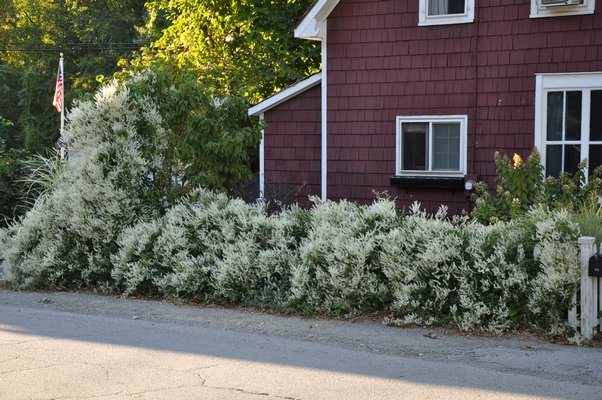

The most common experience that most gardeners have with vines is in trying to get rid of them or at least trying to control or tame the twining tendrils. But for a growing number of enthusiasts, the culture of a particular vine rivals the dedication of rose zealots, delphinium devotees or those with a passion for peonies. This most recent horticultural resurrection is among those who covet the conspicuous and sometimes fragrant flowering clematis vine, which is in garden centers now.
There are about 20 species of this plant that are native to the United States but there are many additional species that are found throughout Europe and the Orient. While most are hardy, there are some that are tender and need a greenhouse in the winter months. There are also some very exciting varieties coming over from England that are hardy and short enough in stature for small gardens, planters and those of us with a few feet instead of a few acres.
As a result of the recently rekindled interest in the vine, many growers have been in the enviable position of not being able to keep up with the demands of consumers and the staked vines that show up at garden centers in full bloom on wire trellises and bamboo stakes are quickly sold out. Packaged semi-dormant plants sold in some garden centers and big box stores are around only slightly longer, even though these are the most common varieties. The result is that you either have to be fast—to get the best ones at the garden center—or patient—growing your own from small plants purchased by mail.
Several summers ago I had quite a different experience. My office was about 200 feet from a circa 1928 country French Empire revival house that sat high up on a hill. From one of the nine second-story bedroom windows, you could see the countryside for miles.
Every day I would walk around the grounds as the plant collections were as old as the structure and I craved getting familiar with them. There was a peony cutting garden with more than 300 plants, gems all throughout the woodland. One day I turned a corner while walking outside the south face of the house and I was astonished to see a vine growing from the ground floor up to a second story gutter. The vine was unmistakably a clematis and if the foliage wasn’t a dead giveaway (which I am ashamed to admit I hadn’t noticed earlier) the glowing blue 6- to 8-inch starlike flowers were.
But back to the present. This great new interest has also lit a fire under breeders and several new varieties are being offered every year. The most popular varieties are hybrids (as well as some species) of
Clematis lanuginosa, C. Jackmanii, C. viticella, C. Florida
and especially
C. patiens
. All of these are large flowering hybrids of the widest range of color, many capable of blooming a second and even a third time in a season if handled properly.
Such blooms are produced by judicious pruning—an art learned over several years. Start pruning early, as new growth reaches 2 to 2½ feet in height, by pinching off less than half the number of growing tips on the elongating vines. This causes a second crop of flowers to be produced three to four weeks after the first bloom has finished.
As you work with these plants, you gain experience in how to handle them. And as I’ve learned from this plant, experience is a great teacher.
Clematis is an elite thoroughbred in the kingdom of plants and they prefer a well-drained, loamy soil. One mistake that East End gardeners make is in planting them where they are subject to wind—a definite no-no. Winter winds desiccate, twist and torment the brittle vines and early spring winds tend to bend and snap young growth, while later in the season they are subject to the accidental clip of the weedwacker.
Clematis hybrids are divided into different groups, that is, groups of plants associated with the principal species involved. For instance, the Montana group consists of plants with white, pink and reddish colored flowers, the most striking of which is the variety Tetrarose. This group is sometimes referred to as the dogwood-flowered clematis. It’s sweetly scented and blooms only once a year and can grow to 20 feet.
English growers have a great interest in the Texensis group, which is a strong grower with small, deep red, bell-shaped flowers. The most beautiful of this group is the variety Dutchess of Albany, with pink, lily-type flowers in great profusion over a long blooming period. It’s semi-herbaceous and dies down to the ground in the winter but in 10 weeks it produces a flowering 12-foot vine.
Of all clematis, the easiest to grow, and wildly popular (though shunned by connoisseurs) is the Sweet Autumn Clematis,
C. paniculata
. It’s widely grown out here and through New England, where you’ll see it blooming in the fall. The vines grow to 20 feet and they produce thousands of tiny, pure white fragrant flowers in September. It’s not uncommon to find them twining through bushes and privet hedges, over walls and up tree trunks.
While these plants are primarily grown for their use as ornamental vines (some of which grow to 35 feet long) there are also a few that are grown for cut flowers. Prince Hendrick is one of these as it has outstanding blue flowers which in the summer, in Holland, can bring several dollars per bloom. Also in Holland, greenhouse-grown blooms grown on 3-foot stems have been getting prices similar to the best of the roses, with White Majesty being the most popular white and William Kennett a deep lavender blue.
Next week, a bit about an English breeder who is introducing 10 new varieties at the upcoming Chelsea Flower Show, his shorter varieties that have made it over the puddle, and more tips on growing these wonderful vines. Keep growing.
 More Posts from Andrew Messinger
More Posts from Andrew Messinger